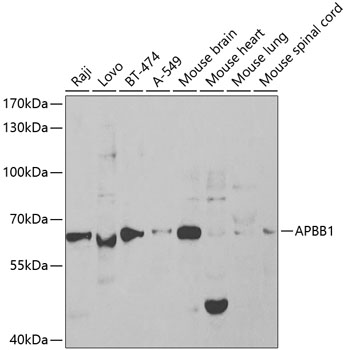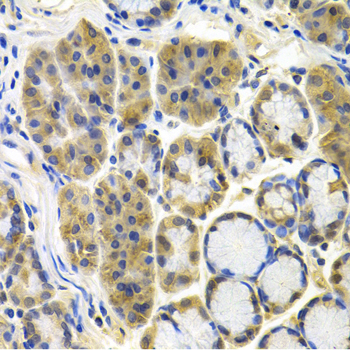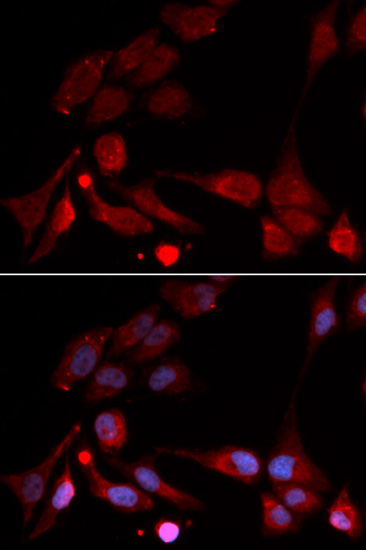Cell Death Antibodies 1
Anti-APBB1 Antibody (CAB1944)
- SKU:
- CAB1944
- Product Type:
- Antibody
- Reactivity:
- Human
- Reactivity:
- Mouse
- Host Species:
- Rabbit
- Isotype:
- IgG
- Research Area:
- Cell Death
Description
| Antibody Name: | Anti-APBB1 Antibody |
| Antibody SKU: | CAB1944 |
| Antibody Size: | 20uL, 50uL, 100uL |
| Application: | WB IHC IF |
| Reactivity: | Human, Mouse |
| Host Species: | Rabbit |
| Immunogen: | Recombinant fusion protein containing a sequence corresponding to amino acids 359-708 of human APBB1 (NP_663722.1). |
| Application: | WB IHC IF |
| Recommended Dilution: | WB 1:50 - 1:200 IHC 1:50 - 1:200 IF 1:50 - 1:200 |
| Reactivity: | Human, Mouse |
| Positive Samples: | Raji, Lovo, BT-474, A-549, Mouse brain, Mouse heart, Mouse lung, Mouse spinal cord |
| Immunogen: | Recombinant fusion protein containing a sequence corresponding to amino acids 359-708 of human APBB1 (NP_663722.1). |
| Purification Method: | Affinity purification |
| Storage Buffer: | Store at -20'C. Avoid freeze / thaw cycles. Buffer: PBS with 0.02% sodium azide, 50% glycerol, pH7.3. |
| Isotype: | IgG |
| Sequence: | PPRN TNPG IKCF AVRS LGWV EMTE EELA PGRS SVAV NNCI RQLS YHKN NLHD PMSG GWGE GKDL LLQL EDET LKLV EPQS QALL HAQP IISI RVWG VGRD SGRD FAYV ARDK LTQM LKCH VFRC EAPA KNIA TSLH EICS KIMA ERRN ARCL VNGL SLDH SKLV DVPF QVEF PAPK NELV QKFQ VYYL GNVP VAKP VGVD VING ALES VLSS SSRE QWTP SHVS VAPA TLTI LHQQ TEAV LGEC RVRF LSFL AVGR DVHT FAFI MAAG PASF CCHM FWCE PNAA SLSE AVQA ACML RYQK CLDA RSQA STSC LPAP PAES VARR VGWT VRRG VQSL WGSL KPKR LGAH TP |
| Gene ID: | 322 |
| Uniprot: | O00213 |
| Cellular Location: | Cell membrane, Cell projection, Cytoplasm, Nucleus, Nucleus speckle, growth cone |
| Calculated MW: | 49kDa/52kDa/53kDa/54kDa/76kDa/77kDa |
| Observed MW: | 63kDa |
| Synonyms: | APBB1, FE65, MGC:9072, RIR |
| Background: | The protein encoded by this gene is a member of the Fe65 protein family. It is an adaptor protein localized in the nucleus. It interacts with the Alzheimer's disease amyloid precursor protein (APP), transcription factor CP2/LSF/LBP1 and the low-density lipoprotein receptor-related protein. APP functions as a cytosolic anchoring site that can prevent the gene product's nuclear translocation. This encoded protein could play an important role in the pathogenesis of Alzheimer's disease. It is thought to regulate transcription. Also it is observed to block cell cycle progression by downregulating thymidylate synthase expression. Multiple alternatively spliced transcript variants encoding different isoforms have been described for this gene. |
| UniProt Protein Function: | Fe65: adapter protein that forms a transcriptionally active complex with the gamma-secretase-derived amyloid precursor protein (APP) intracellular domain. Plays a central role in the response to DNA damage by translocating to the nucleus and inducing apoptosis. May act by specifically recognizing and binding histone H2AX phosphorylated on Y142 (H2AXpY142) at double-strand breaks (DSBs), recruiting other pro-apoptosis factors such as JNK1. Required for histone H4 acetylation at double-strand breaks (DSBs). Its ability to specifically bind modified histones and chromatin modifying enzymes such as TIP60, probably explains its trancription activation activity. |
| UniProt Protein Details: | Protein type:Apoptosis; Adaptor/scaffold; Transcription regulation Chromosomal Location of Human Ortholog: 11p15 Cellular Component: growth cone; lamellipodium; cytoplasm; plasma membrane; nuclear speck; synapse; nucleus Molecular Function:protein binding; histone binding; beta-amyloid binding; chromatin binding; transcription factor binding Biological Process: axon guidance; extracellular matrix organization and biogenesis; positive regulation of DNA repair; transcription, DNA-dependent; positive regulation of apoptosis; apoptosis; positive regulation of transcription, DNA-dependent; neuron migration; signal transduction; negative regulation of thymidylate synthase biosynthetic process; negative regulation of neuron differentiation; regulation of transcription, DNA-dependent; axonogenesis; double-strand break repair; visual learning; positive regulation of transcription from RNA polymerase II promoter; negative regulation of cell growth; cell cycle arrest; response to DNA damage stimulus |
| NCBI Summary: | The protein encoded by this gene is a member of the Fe65 protein family. It is an adaptor protein localized in the nucleus. It interacts with the Alzheimer's disease amyloid precursor protein (APP), transcription factor CP2/LSF/LBP1 and the low-density lipoprotein receptor-related protein. APP functions as a cytosolic anchoring site that can prevent the gene product's nuclear translocation. This encoded protein could play an important role in the pathogenesis of Alzheimer's disease. It is thought to regulate transcription. Also it is observed to block cell cycle progression by downregulating thymidylate synthase expression. Multiple alternatively spliced transcript variants encoding different isoforms have been described for this gene. [provided by RefSeq, Mar 2012] |
| UniProt Code: | O00213 |
| NCBI GenInfo Identifier: | 12229629 |
| NCBI Gene ID: | 322 |
| NCBI Accession: | O00213.2 |
| UniProt Secondary Accession: | O00213,Q7Z324, Q96A93, A1E379, A6NH82, A6NL69, B7Z1J5 B7Z1J6, B7Z2Y0, D3DQT2, V9GYK0, V9GYT4, |
| UniProt Related Accession: | O00213 |
| Molecular Weight: | 52,656 Da |
| NCBI Full Name: | Amyloid beta A4 protein-binding family B member 1 |
| NCBI Synonym Full Names: | amyloid beta (A4) precursor protein-binding, family B, member 1 (Fe65) |
| NCBI Official Symbol: | APBB1 |
| NCBI Official Synonym Symbols: | RIR; FE65; MGC:9072 |
| NCBI Protein Information: | amyloid beta A4 precursor protein-binding family B member 1; stat-like protein; adaptor protein FE65a2 |
| UniProt Protein Name: | Amyloid beta A4 precursor protein-binding family B member 1 |
| UniProt Synonym Protein Names: | Protein Fe65 |
| Protein Family: | Amyloid beta A4 precursor protein-binding family |
| UniProt Gene Name: | APBB1 |
| UniProt Entry Name: | APBB1_HUMAN |









